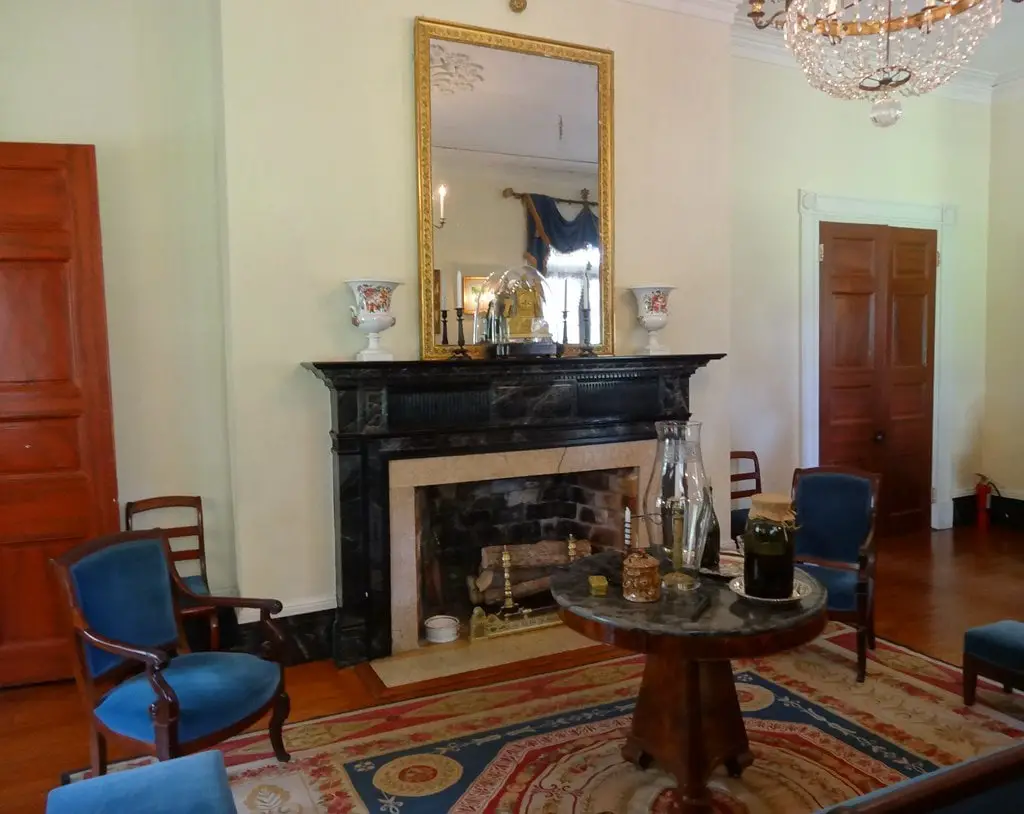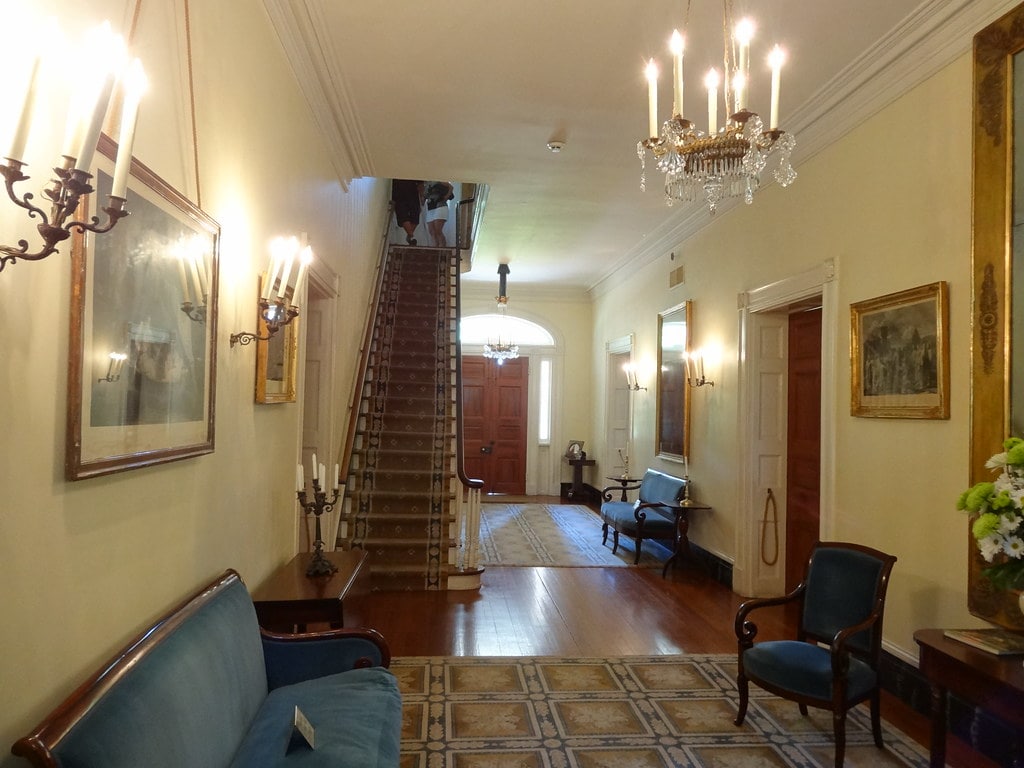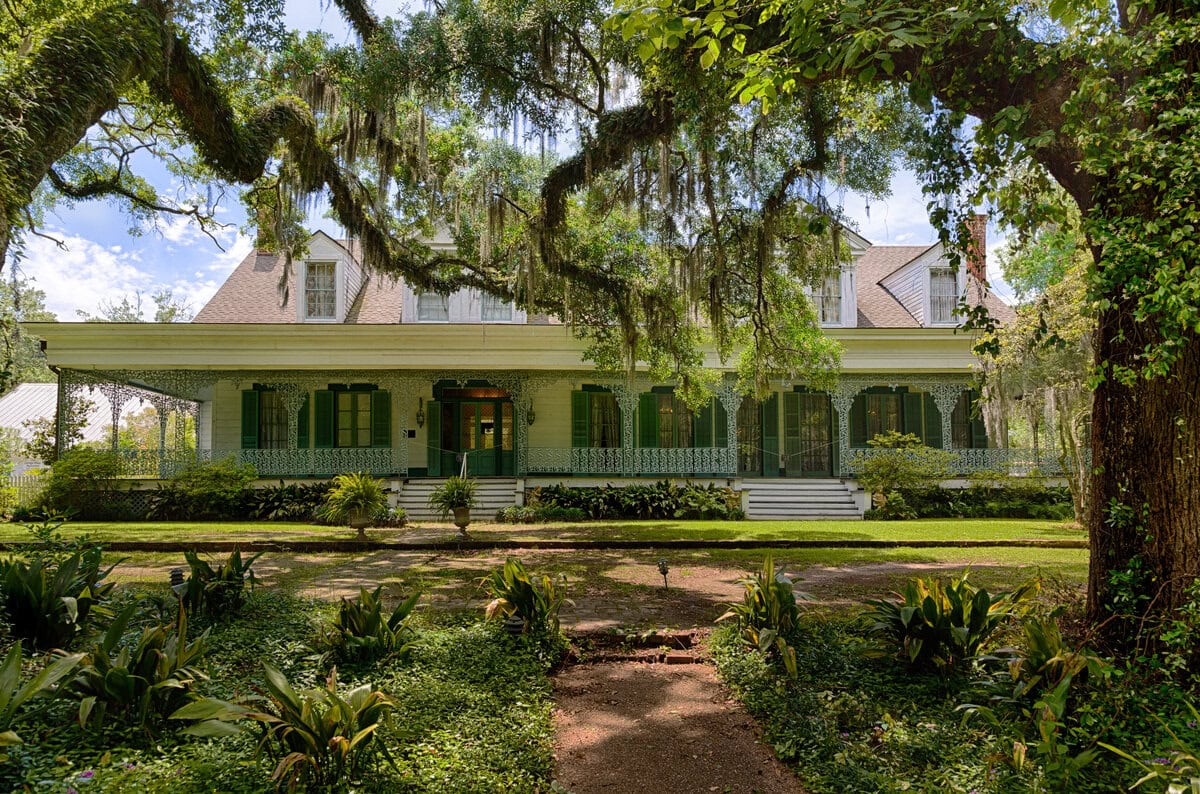What You Can Still See from the Road
Even if you miss the turnoff, the oaks are hard to forget. They run straight and quiet, 28 in a line, flanking a crushed shell path that leads to the white-columned front of Oak Alley Plantation.
Vacherie, Louisiana, doesn’t always pull tourists the way larger cities do, but this stretch of riverbank holds its weight.
Anyone searching for things to do near New Orleans might stop for the trees—and stay for what happened behind them.
Land Deals and Bricks
Oak Alley Plantation was never a spontaneous venture.
In 1830, Valcour Aime, already called the “King of Sugar” by peers in the industry, bought the property and named it Bon Séjour.
He already owned nearby plantations and used the land primarily for sugarcane.
Six years later, in a private exchange, he handed the acreage to his brother-in-law, Jacques Télesphore Roman, trading it for another plantation.
By 1837, Jacques Roman had enslaved workers begin construction of the house that stands today.
George Swainy handled oversight. The house took two years to build and was finished in 1839.
Its design followed the Greek Revival style, which was in vogue at the time.
Joseph Pilié, an architect and also Roman’s father-in-law, likely provided the design.
The materials were made on site: bricks from clay dug nearby, stucco for the facade, and slate for the roof.
The name Oak Alley Plantation came from the pre-existing double row of southern live oaks, likely planted in the early 1700s.
The alley predates the house by roughly a century and runs about 800 feet from the mansion to the levee along the Mississippi River.
Even then, the trees shaped how people entered and understood the place.
Roman kept them in place. He let them lead.
Sugar Markets and a Thin-Shelled Pecan
By the mid-1840s, sugarcane was still the primary business at Oak Alley Plantation, but the work happening in the garden would be remembered longer than the harvest numbers.
An enslaved gardener named Antoine, trained in grafting techniques, was experimenting with pecans.
In the winter of 1846, he produced a variety with a shell so thin it could be cracked by hand.
They called it the “paper shell” pecan.
Three decades later, the same variety entered competition at the 1876 Centennial Exposition in Philadelphia.
It won a prize and picked up a new name: the Centennial Variety.
For a while, that nut turned up across southern Louisiana.
Commercial groves were planted at nearby estates like Nita Plantation, which aimed to develop pecans as a cash crop.
But in 1890, the Mississippi broke its banks near Nita and wiped out the orchard.
Jacques Roman didn’t live to see the pecans gain attention.
He passed away from tuberculosis in 1848. His wife, Celina Roman, tried to manage the estate herself.
Her background didn’t include plantation economics, and her financial decisions pushed the property toward insolvency.
In 1859, their son Henri took over management, but the sugar trade was already unstable.
The period of hostilities didn’t destroy the buildings, but the business collapsed anyway.
When slavery ended, the labor system that kept the cane harvest moving vanished.
By 1866, the Roman family sold the property at auction to John Armstrong and Hubert Bonzano for $32,800.
That figure reflects more than land value—it measured a financial unraveling.

Cattle Fencing and a Clean Roofline
Ownership changed several times over the next decades, but no buyer managed to keep the place running at full scale.
The buildings deteriorated. By the 1920s, vines had overtaken parts of the facade.
Structural repairs were overdue, and the house was no longer suited for sugar operations.
In 1925, Andrew Stewart purchased the property as a gift for his wife, Josephine.
She had grown up on a Texas cattle ranch and knew how to manage livestock.
Sugar had already taken a downturn—disease had weakened the crop early in the century—so the Stewarts ran Oak Alley Plantation as a cattle operation.
Josephine didn’t just fence pastures and stock barns.
She also hired architect Richard Koch to oversee the restoration of the house.
It had been nearly a century since completion, and much of the original detailing had worn away or been removed.
Koch moved the staircase from the southwest corner to the central hall and replaced black-and-white marble flooring with wood.
He added dormers—three per side—on the slate roof.
By the 1960s, sugarcane made its return. Market conditions had shifted, and new varieties were more resilient.
The Stewarts oversaw this transition but remained the last private residents of the main house.
Josephine passed in 1972. In her will, she left the estate to the Oak Alley Foundation.
The house and grounds opened to the public in 1976, shifting the operation from agriculture to preservation.
Sugar and cattle became part of the story, not the business plan.
Shadows on the Balcony
People don’t always come to Oak Alley Plantation for the history.
Some come to see what moves when it shouldn’t.
The stories started long after the sugar was gone, but they’ve stuck—enough to pull in paranormal tours and late-night curiosity.
The most persistent figure is a woman in black. Some say she walks the widow’s walk.
Others place her on horseback, riding the line where the oaks meet the levee.
No one agrees on her name. Some guess Louise Roman, who left the plantation for a convent after a fall on the staircase.
Others point to Celine, her mother, who managed the estate into collapse.
The sightings never bring her close. She’s always just leaving the frame.
There’s also the sound of horse hooves on gravel, stopping at the door.
People hear them, step outside, and find nothing.
More than one staff member has said the rocking chairs shift on their own, slow and steady, when no wind moves through the corridor.
One group on a guided tour watched a candlestick arc across a room with no one near it. There was no reply.
The mansion doesn’t promote the stories, but it doesn’t deny them either.
Visitors sometimes mention cold spots in the hallway or a voice upstairs when no one is scheduled there.
Whether they come for facts or something less solid, they all walk the same shell path back out.
The columns look different when you’re glancing back at them.

Floor Plans and Fieldstone
Oak Alley Plantation was built to be seen. The symmetry starts at the front door and runs straight through.
A central hallway cuts the house in half, front to back, on both floors.
Every room branches from that line. No surprises, no flourishes—just a clear, measured layout.
Outside, the message is louder. Greek Revival columns wrap all four sides, 28 in total, lining up with the 28 live oaks planted along the entry path.
The match isn’t subtle. It’s architectural choreography.
The walls—16 inches thick—were made with on-site brick, coated in white stucco to look like stone.
The original slate roof had four dormers, one per side.
Some updates were practical. The rear rooms on the first floor were cut and refitted as a kitchen.
Others were aesthetic—done to make the house livable again, without erasing what was left.
Out back, a formal garden was planted to separate the house from the old car garage.
That garage now holds the Sugarcane Theater—a small exhibit space where videos and displays trace the labor behind Louisiana’s cane fields.
No part of this layout happened by accident. Even the tree line, planted a century earlier, feeds the same geometry.
The whole place moves on grids—silent, rigid, deliberate.
Sound Stages and Sidewalk Crowds
Oak Alley Plantation doesn’t need a filter. It looks like a movie set before anyone rolls a camera.
That’s why filmmakers show up. In 1964, “Hush…Hush, Sweet Charlotte” used the mansion for exterior shots.
By the 1980s, it had shown up again in “The Long Hot Summer” and “Netherworld.” Then came 1994.
“Interview with the Vampire” gave the house a name on screen—Louis’ estate—and put it in front of millions.
It didn’t need much set dressing. The columns, the porch, the allée—those were already in place.
Directors leaned on what was there. Tourists followed. They still do. The porch sees more camera phones now than any parlor room inside.
Oak Alley Plantation crossed into games in 2018, when “Red Dead Redemption 2” featured Braithwaite Manor, a digital echo of the real thing.
No official credit, no licensing deal—it didn’t need one.
The resemblance was exact enough to catch. The house became its shorthand.
In 1974, the site was named a National Historic Landmark.
The listing focused on three things: the architecture, the oak row, and the pecan hybrid developed on the grounds.
That’s the formal record. The rest travels by screen grabs, field trips, wedding photos, and location credits.
Sugar and cattle don’t move through here anymore. What sells now is the image, framed by branches, filtered by memory, recirculated every weekend.

🍀







